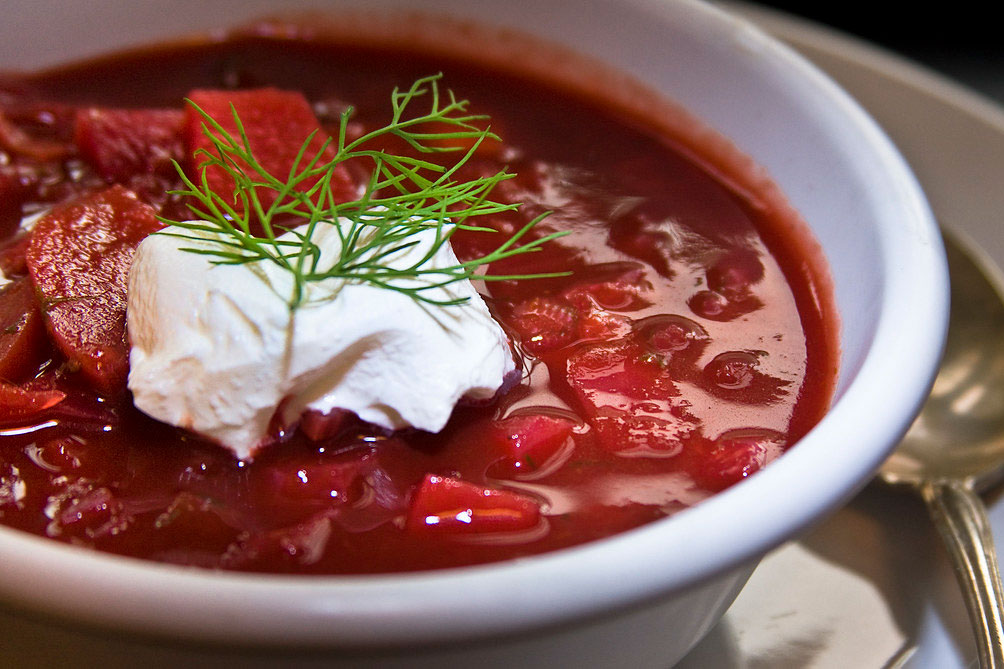A Brief History of Borshch

Borshch is known for its signature red color.
Photo by ... (Creative Commons)
Some know it as borshch, some as borscht—a beet by any other name would smell as sweet. In 2022, UNESCO declared the iconic sour soup, known for its signature crimson color and occasional smetana (sour cream) garnish, to be Ukrainian “cultural heritage in need of urgent safeguarding,” citing the ongoing Russian invasion and the consequent displacement of Ukrainians from their ancestral home as a threat to “the cultural contexts necessary for the cooking and consumption of borscht.” The designation by the international cultural authority was widely seen as a landmark decision in the ongoing cultural dispute between the two countries on borshch’s true country of origin.
Borshch is a transliteration of the word борщ, common to various Eastern Slavic languages including Ukrainian, which means “hogweed.” As the name suggests, hogweed used to be the primary ingredient of the soup, but was gradually replaced by others over time—most notably beets in the Ukrainian variant. Over time, the root vegetable became synonymous with the modern form of the dish as we know it today.
Former Center for Folklife and Cultural Heritage intern and Ukrainian emigrant Diana Pilipenko spoke to borshch's status as a symbol of national pride: “One sure way to get under the skin of a Russian chauvinist is to refer to borscht as a Ukrainian dish. Borscht is a Ukrainian dish. Unequivocally. Borscht is a dish rooted in scarcity and hardship, but one that has evolved into a staple of the vibrant Ukrainian cuisine.”
“When I was a little girl growing up in Ukraine, my mom would feed me borscht—sometimes serving it cold—for breakfast. In those days, the slimy texture of boiled cabbage made me recoil,” Pilipenko said. “Today, as I watch the horror of Russia’s war from afar, few things make me feel closer to my ancestral lands than borscht. Its rich flavor and color evoke the happy memories of my childhood. Its earthiness is the earthiness of Ukraine and her resilient people.”
Traditionally, the dish also comprises meat stock (most commonly chicken or beef) and sauteed vegetables. In the recipe that 2023 Folklife Festival participant Dara Sereda will bring to the National Mall, chicken thighs, white cabbage, onions, carrots, garlic, vegetable oil, tomato paste, and various spices will be simmered together for a rich, aromatic blend.
In a similar fashion to many other folk recipes, borshch began as a peasant food sourced from accessible ingredients. Across turbulent periods of exacting conflict within Eastern Europe, the soup became popularized across all social classes as a convenient, cheap, and filling meal. Through cross-cultural encounters and exchange, borshch garnered increasingly diverse variants across the region. In Georgia and Azerbaijan, it may include red chili flakes, polenta, and sour cherry leaves in Moldova, and unripe plums and apricots in Romanian renditions. Borshch may even be found in China as luo suo tang (literally “Russian soup”), though you may find the beet base swapped with tomatoes. Soviet astronauts even brought the sturdy soup to outer space!

Over time, borshch’s universal appeal led to its fixed presence in rituals and celebrations. In the Podolia region of southwestern Ukraine and northeastern Moldova, the third day of wedding celebrations is known as do nevistky na borshch, meaning the day for visiting your daughter-in-law to eat borscht.
The variant most Americans may be familiar with, accompanied by the slightly different spelling “borscht,” is the Ashkenazi Jewish take on the soup. The extra t comes from the transliteration of the Yiddish word באָרשט . Since the mixture of meat and dairy is forbidden in kashrut (Jewish dietary law), Ashkenazi borscht is often made as a light, vegetarian soup without meat stock. Jews living in Eastern Europe found the soup a perfect fit for the requirements of certain holiday occasions. Root vegetables such as beets were hardy ingredients that survived storage over the winters, perfect for the early spring celebration of Passover. Shavuot, or the Feast of Weeks, traditionally involves eating dairy foods, where the smetana topping of borscht meets the criteria.
Pogroms—anti-Jewish riots in Eastern Europe beginning in the early 1880s—forced many Ashkenazi Jews to seek refuge from persecution by immigrating to the United States, carrying traditions of borscht with them. Several different regions of the United States became known for their vitality of Jewish culture near the turn of the twentieth century.
Most famously, a chain of summer resorts in the Catskill Mountains has been nicknamed the Borscht Belt for its popularity among Jewish families. Formed in the 1920s and 1930s in response to Jewish exclusion from mainstream hospitality options, the Borscht Belt assumed a central role within the Jewish American community as a cultural epicenter. Famed for its vast entertainment options, one could expect to find comedians by the likes of Joan Rivers, Carl Reiner, and Mel Brooks, who got their start in evening hotel lobby performances, or collegiate a cappella groups such as the Doox of Yale, who have traditionally toured there every winter.
Borshch’s plural possibilities have enabled the beet stew to serve as a cultural liaison between different ethnic and diasporic groups around the world, with endless dialogues to be found by comparing the similarities and differences between each cultural variant. Smithsonian Folklife Festival visitors will have the opportunity to hear stories of borshch’s personal significance from Ukrainian participants on Friday, July 7, at 11 a.m. at the Festival Foodways demonstration kitchen.
Daniel Zhang is a media intern at the Smithsonian Folklife Festival from Edison, New Jersey. He is a rising sophomore at Yale University studying h umanities. He sings with the Doox of Yale and leads tours at the Yale University Art Gallery.

